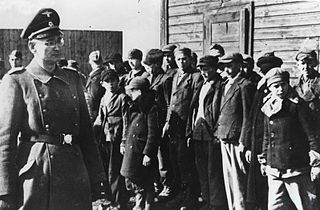
Lebensraum is a German concept of expansionism and Völkisch nationalism, the philosophy and policies of which were common to German politics from the 1890s to the 1940s. First popularized around 1901, Lebensraum became a geopolitical goal of Imperial Germany in World War I (1914–1918), as the core element of the Septemberprogramm of territorial expansion. The most extreme form of this ideology was supported by the Nazi Party and Nazi Germany. Lebensraum was a leading motivation of Nazi Germany to initiate World War II, and it would continue this policy until the end of the conflict.

The Generalplan Ost, abbreviated GPO, was Nazi Germany's plan for the genocide, extermination and large-scale ethnic cleansing of Slavs, Eastern European Jews, and other indigenous peoples of Eastern Europe categorized as "Untermenschen" in Nazi ideology. The campaign was a precursor to Nazi Germany's planned colonisation of Central and Eastern Europe by Germanic settlers, and it was carried out through systematic massacres, mass starvations, chattel labour, mass rapes, child abductions, and sexual slavery.

The Reichskommissariat Ostland was established by Nazi Germany in 1941 during World War II. It became the civilian occupation regime in Lithuania, Latvia, Estonia, and the western part of Byelorussian SSR. German planning documents initially referred to an equivalent Reichskommissariat Baltenland. The political organization for this territory – after an initial period of military administration before its establishment – involved a German civilian administration, nominally under the authority of the Reich Ministry for the Occupied Eastern Territories led by Nazi ideologist Alfred Rosenberg, but actually controlled by the Nazi official Hinrich Lohse, its appointed Reichskommissar.

Friedrich-Wilhelm Krüger was a German paramilitary commander in charge of, and personally involved in progressive annihilation of the Polish nation, its culture, its heritage and its wealth. Long before the war he was a high-ranking member of the SA and the SS. Between 1939 and 1943 he was the Higher SS and Police Leader in the General Government, giving him command of all police and security forces in German-occupied Poland. In this capacity, he organized and supervised numerous crimes against humanity and had major responsibility for the German genocide of the Polish nation: the extermination of six million Poles and massive destruction, degradation and impoverishment of the Polish state. He committed suicide in May 1945.

Reichskommissariat Moskowien was the civilian occupation-regime that Nazi Germany intended to establish in central and northern European Russia during World War II, one of several similar Reichskommissariate. It was also known initially as the Reichskommissariat Russland, but was later renamed as part of German policies of partitioning Soviet Russia as a state. Siegfried Kasche was the projected Reichskomissar, but due to the Wehrmacht's failure to occupy the territories intended to form the Reichskommissariat, it remained on paper only.

Untermensch is a German language word literally meaning 'underman', 'sub-man', or 'subhuman', which was extensively used by Germany's Nazi Party to refer to their opponents and non-Aryan people they deemed as inferior. It was mainly used against "the masses from the East", that is Jews, Roma, and Slavs.
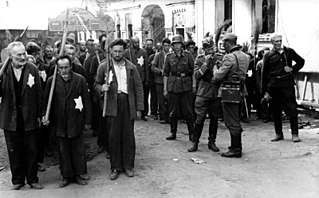
The German invasion of the Soviet Union started on 22 June 1941 and led to a German military occupation of Byelorussia until it was fully liberated in August 1944 as a result of Operation Bagration. The western parts of Byelorussia became part of the Reichskommissariat Ostland in 1941, and in 1943, the German authorities allowed local collaborators to set up a regional government, the Belarusian Central Rada, that lasted until the Soviets reestablished control over the region. Altogether, more than two million people were killed in Belarus during the three years of Nazi occupation, around a quarter of the region's population, or even as high as three million killed or thirty percent of the population, including 500,000 to 550,000 Jews as part of the Holocaust in Belarus. In total, on the territory of modern Belarus, more than 9,200 villages and settlements, and 682,000 buildings were destroyed and burned, with some settlements burned several times. By the end of the war, Belarus had lost half of its population as a result of death and moving.
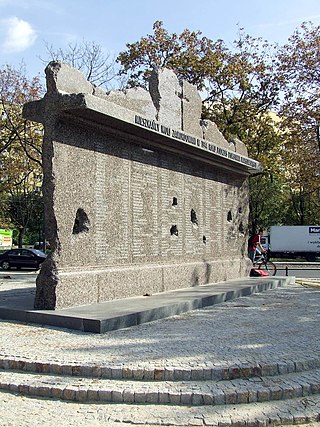
Crimes against the Polish nation committed by Nazi Germany and Axis collaborationist forces during the invasion of Poland, along with auxiliary battalions during the subsequent occupation of Poland in World War II, included the genocide of millions of Polish people, especially the systematic extermination of Jewish Poles. These mass killings were enacted by the Nazis with further plans that were justified by their racial theories, which regarded Poles and other Slavs, and especially Jews, as racially inferior Untermenschen.
Holocaust victims were people targeted by the government of Nazi Germany based on their ethnicity, religion, political beliefs, disability or sexual orientation. The institutionalized practice by the Nazis of singling out and persecuting people resulted in the Holocaust, which began with legalized social discrimination against specific groups, involuntary hospitalization, euthanasia, and forced sterilization of persons considered physically or mentally unfit for society. The vast majority of the Nazi regime's victims were Jews, Sinti-Roma peoples, and Slavs but victims also encompassed people identified as social outsiders in the Nazi worldview, such as homosexuals, and political enemies. Nazi persecution escalated during World War II and included: non-judicial incarceration, confiscation of property, forced labor, sexual slavery, death through overwork, human experimentation, undernourishment, and execution through a variety of methods. For specified groups like the Jews, genocide was the Nazis' primary goal.

The expulsion of Poles by Germany was a prolonged anti-Polish campaign of ethnic cleansing by violent and terror-inspiring means lasting nearly half a century. It began with the concept of Pan-Germanism developed in the early 19th century and culminated in the racial policy of Nazi Germany that asserted the superiority of the Aryan race. The removal of Poles by Germany stemmed from historic ideas of expansionist nationalism. It was implemented at different levels and different stages by successive German governments. It ended with the defeat of Nazi Germany in 1945.
The Parczew partisans were fighters in irregular military groups participating in the Jewish resistance movement against Nazi Germany and its collaborators during World War II. The name of the partisan force, coined by the Holocaust historians, is borrowed from the Parczew forest located a short distance away from Lublin, halfway to the town of Sobibór, the location of the Sobibór extermination camp during the Holocaust in occupied Poland. The Jews who managed to escape from the camp hid in there along with the considerable number of Jewish families of the Lublin Ghetto.
The Hunger Plan was a partially implemented plan developed by Nazi bureaucrats during World War II to seize food from the Soviet Union and give it to German soldiers and civilians. The plan entailed the genocide by starvation of millions of Soviet citizens following Operation Barbarossa, the 1941 invasion of the Soviet Union. The plan created a famine as an act of policy, killing millions of people.
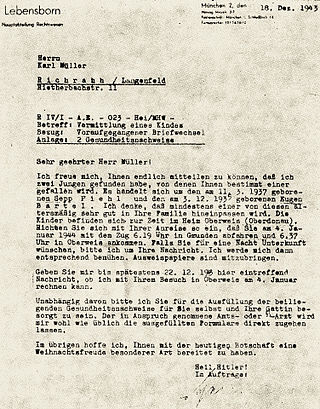
During World War II, around 200,000 ethnic Polish children as well as an unknown number of children of other ethnicities were abducted from their homes and forcibly transported to Nazi Germany for purposes of forced labour, medical experimentation, or Germanization.

Ostarbeiter was a Nazi German designation for foreign slave workers gathered from occupied Central and Eastern Europe to perform forced labor in Germany during World War II. The Germans started deporting civilians at the beginning of the war and began doing so at unprecedented levels following Operation Barbarossa in 1941. They apprehended Ostarbeiter from the newly-formed German districts of Reichskommissariat Ukraine, District of Galicia, and Reichskommissariat Ostland. These areas comprised German-occupied Poland and the conquered territories of the Soviet Union. According to Pavel Polian, although the Ostarbeiter from most occupied territories were predominantly men, of the "eastern workers" taken from occupied Soviet territories over 50% were women, and of those from Poland nearly 30% were women. Eastern workers included ethnic Ukrainians, Poles, Belarusians, Russians, Armenians, Tatars, and others. Estimates of the number of Ostarbeiter range between 3 million and 5.5 million.

The use of slave and forced labour in Nazi Germany and throughout German-occupied Europe during World War II took place on an unprecedented scale. It was a vital part of the German economic exploitation of conquered territories. It also contributed to the mass extermination of populations in occupied Europe. The Germans abducted approximately 12 million people from almost twenty European countries; about two thirds came from Central Europe and Eastern Europe. Many workers died as a result of their living conditions – extreme mistreatment, severe malnutrition and abuse were the main causes of death. Many more became civilian casualties from enemy (Allied) bombing and shelling of their workplaces throughout the war. At the peak of the program, the forced labourers constituted 20% of the German work force. Counting deaths and turnover, about 15 million men and women were forced labourers at one point during the war.

The Zamość uprising comprised World War II partisan operations, 1942–1944, by the Polish resistance against Germany's Generalplan-Ost forced expulsion of Poles from the Zamość region (Zamojszczyzna) and the region's colonization by German settlers.
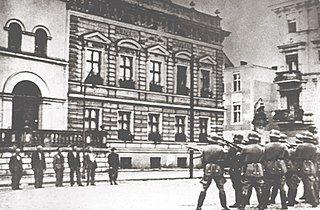
The Intelligenzaktion, or the Intelligentsia mass shootings, was a series of mass murders which was committed against the Polish intelligentsia early in the Second World War (1939–45) by Nazi Germany. The Germans conducted the operations in accordance with their plan to Germanize the western regions of occupied Poland, before their territorial annexation to the German Reich.

The Expulsion of Poles by Nazi Germany during World War II was a massive operation consisting of the forced resettlement of over 1.7 million Poles from the territories of German-occupied Poland, with the aim of their Germanization between 1939 and 1944.

The occupation of Poland by Nazi Germany and the Soviet Union during World War II (1939–1945) began with the Invasion of Poland in September 1939, and it was formally concluded with the defeat of Germany by the Allies in May 1945. Throughout the entire course of the occupation, the territory of Poland was divided between Nazi Germany and the Soviet Union (USSR), both of which intended to eradicate Poland's culture and subjugate its people. In the summer-autumn of 1941, the lands which were annexed by the Soviets were overrun by Germany in the course of the initially successful German attack on the USSR. After a few years of fighting, the Red Army drove the German forces out of the USSR and crossed into Poland from the rest of Central and Eastern Europe.

The ethnic cleansing of Zamojszczyzna by Nazi Germany during World War II was carried out as part of a greater plan of forcible removal of the entire Polish populations from targeted regions of occupied Poland in preparation for the state-sponsored settlement of the ethnic German Volksdeutsche. The operation of mass expulsions from Zamojszczyzna region around the city of Zamość was carried out between November 1942 and March 1943 on direct order from Heinrich Himmler. It was preplanned by both Globocnik from Action Reinhard and Himmler, as the first stage of the eventual murderous ethnic cleansing ahead of projected Germanization of the entire General Government territory.
